Vol 4 No. 39 TROPIC LIGHTNING NEWS September 29, 1969
Index
| Security is a warm blanket. For Linus
maybe, but in Vietnam a warm blanket is not needed half as much as security on
the telephone or around your hootches. Chances are the Vietnamese laborer
cannot understand what you are saying, but why take chances. A little less talk on or off base camp will do the trick. You can bet your life on it. DEROS. Do it the safe way. |
Gunships Sic ‘Em on Enemy
By PFC GREG STANMAR
CU CHI - Hammock strings tripped up the enemy, bringing the full
wrath of the 2d Brigade Golden Dragons down on the NVA after strong contact
recently.
Alpha Company, 2d Battalion, 14th Infantry, in force with a company
of the 2d Battalion, 49th ARVN Regiment came into contact with a North
Vietnamese unit in a battle that left 36 enemy dead and no friendly casualties.
THE ACTION brought congratulations from Major General Harris W.
Hollis, new commander of the Tropic Lightning Division, to the ground, air and
artillery units engaged in the victory.
Evidence of recent enemy activity in the area came to the Dragons
when they found strings from hammocks tied to trees. The NVA unit
apparently did not have time to untie the hammocks and instead just tore them
from their moorings.
AT THIS POINT the infantrymen began to receive “a heavy volume of
fire, including RPG rounds,” said Master Sergeant Clarence Wise of
Jackson. Ohio. “None of it was effective, though.”
Air strikes and artillery were called, but enemy firing flared up
again as soon as the strikes ended. An encore by the Air Force, however,
slowed enemy firing to sporadic sniper rounds.
An hour and a half after the first enemy fire, it was quiet enough
to permit a sweep of the area. The sweep showed artillery had killed 22
Communists and air strikes 14, by actual body count.
And They Flush Hung-up Foes
By SP4 FRANK DITTO
CU CHI - An LOH helicopter is down!
The 2d Battalion, 14th Infantry Golden Dragons are called in to
provide ground security for the downed chopper.
AFTER THE SMALL aircraft has been extracted, the Fire Brigade
Infantrymen are lifted back to their Support Fire Base.
But as the Stinger gunships are returning to Cu Chi after convoying
the assault helicopters, one spots movement in a thickly wooded area north of
Trung Lap.
Circling above the target area, gunners observe five North
Vietnamese soldiers making a dash for cover. The gunships drop down and
circle the area with renewed intensity.
SUDDENLY A burst of AK-47 rifle fire streaks upward. Contact
is made and the battle begins.
Lieutenant Colonel Donald O. Crutchley of Bethesda, Md., the Golden
Dragon commander, radios for air strikes as the gunships continue to engage the
enemy.
Meanwhile, the 116th Assault Helicopter Company is called to lift
the Golden Dragons’ Delta Company into the area for a sweep of the
battleground.
AS THE NINE ships of the lift scream into the landing zone, the
artillery lifts and the tense foot soldiers begin the push through heavily booby
trapped brush.
Huge bomb craters smolder as the Fire Brigade troopers work their
way through the contact zone, blowing bunkers and keeping in constant touch with
the command-and-control helicopter.
After a thorough search, the Golden Dragons withdraw from the
battlefield to be picked up once again by aircraft. A 38 body count is
recorded for the day’s activities. Twelve enemy rifles and 17 bunkers
are listed as destroyed.
Urges End to Aggression
CG Says Farewell to Reds
When Major General Ellis W. Williamson stepped down September 15 as commander of
Tropic Lightning, he bid farewell to the troops he had led for more than 13
months. As always going one step beyond the expected, the general also
directed a special farewell message to the Viet Cong-North Vietnamese forces who
have opposed the men under his command. A Division G-5 team translated the
message into Vietnamese and printed it on 400,000 leaflets that were air-dropped
across Tropic Lightning’s operations area. Addressed to “the officers,
soldiers, and cadre of the VC/NVA opposing the 25th Infantry (US) Division,”
it read:
As the time for my departure from Vietnam draws near, I am deeply
saddened by the thought of all the fine, honorable young Vietnamese patriots,
from both the North and South, who have died supposedly for the same cause - the
right for all Vietnamese to live in peace and happiness free from oppression and
interference.
I am even more saddened because those from the North left their
families and died not to fulfill the wishes of the Southerners but to fulfill
the selfish wishes of the Northern leaders who want to dominate the South and
impose their form of government on an unwilling people.
In 1965 when I commanded the 173rd Airborne Brigade, your units
were strong, your predecessors were well fed and their leaders were promising
them easy victory on the battlefield. Now, four years later, you
have replaced your fallen compatriots, your units are weak and must use sapper
tactics, you often go hungry and are still being promised victory.
As you probably have already seen with your own eyes, the people of
the South are not cruelly oppressed nor are they starving as you were told.
They are working in the villages with representatives of their freely elected
government to build a better life for all. The military forces of South
Vietnam are growing stronger day by day and are capable of preventing you from
destroying all of the advancements made by the free people of South Vietnam.
I urge you to leave the path that can only lead to your
annihilation, and to join the free people of South Vietnam in the efforts to
build a more prosperous life for all Vietnamese. Those of you whose homes
are in the South can be reunited with your families through the GVN’s Chieu
Hoi Program.
For those whose homes are in the North, go to the nearest GVN
outpost or hamlet. There you will be treated kindly and given the
opportunity of joining your brothers in the South in their effort to help build
a free and prosperous South Vietnam, and wait for the day that you can return to
your loved ones.
As I depart your country I wish peace and tranquility for the
Vietnamese people, whom I admire and respect.
- Major General Ellis W. Williamson –
| SWEEPING THROUGH a contact area, Golden Dragons of the 2d Battalion, 14th Infantry move past still-smoldering bomb craters during a battle with NVA troops. (PHOTO BY SP4 FRANK DITTO) |  |
Page 2 TROPIC LIGHTNING NEWS September 29, 1969
Decorated
| SILVER STAR | |
|
LTC Burton J. Walrath, HHC, 2d Bn, 12th Inf LTC John R. Randolph, HHC, 4th Bn, 9th Inf LTC George E. Taylor, HHC, 4th Bn, 23d Inf LTC William E. Ebel, HHC, 2d Bn, 27th Inf LTC Carl M. Mott, HHS Btry, 7th Bn, 11th Arty MAJ Robert P. Greene, Co B, 25th Avn Bn MAJ Max A. Ray, Co C, 1st Bn, 5th Inf CPT Thomas L. Waldera, Co D, 2d Bn, 14th Inf CPT James F. Norman, Jr., Co B, 4th Bn, 23d Inf CPT William Goodman, HHC, 1st Bn, 27th Inf CPT Jay A. Yurchuck, Co D, 2d Bn, 27th Inf 1LT William J. Miller, Co C, 25th Avn Bn 1LT Jeffery D. Fuller, Co D, 2d Bn, 14th Inf 1LT Jack C. Dopler, Co B, 25th Avn Bn 1LT David G. Scott, HHS Btry, 2d Bn, 77th Arty 2LT Wiliam J. O’Hara, Co B, 4th Bn, 23d Inf CW2 James D. Skelton, Co B, 25th Avn Bn WO1 Steven R. Kline, Co B, 25th Avn Bn SSM Walter F. Corvin, HHC, 1st Bn, 27th Inf |
SSG Bobby D. Cashtoe, Co A, 2d Bn, 22d Inf SP5 Thomas W. Barlow, HHC, 2d Bn, 27th Inf SP4 Gordon L. Maga, Co B, 2d Bn, 27th Inf SP4 John J. Fahey, Co B, 2d Bn, 27th Inf SP4 Harold A. Tsadiasi, Co D, 2d Bn, 14th Inf SP4 Donald Davis, Co A, 65th Engr Bn SP4 James Tsosie, Co D, 2d Bn, 14th Inf SP4 Jerry L. Stewart, Co D, 2d Bn, 14th Inf SP4 James P. Cipolla, Co B, 2d Bn, 27th Inf SP4 Walter A. Kocon, Co B, 4th Bn, 23d Inf SP4 Joel P. Dufrain, HHC, 2d Bn, 27th Inf PFC Homer L. Dawson, Co C, 2d Bn, 27th Inf PFC Michael J. Hubbard, Co D, 2d Bn, 14th Inf PFC Samuel L. Dison, Co D, 2d Bn, 27th Inf PFC John E. Ford, B Btry, 2d Bn, 77th Arty PFC Gregory M. Ford, Co D, 2d Bn, 14th Inf PFC Richard D. Shannon, Co B, 2d Bn, 27th Inf PFC Milton McDougal, Co A, 2d Bn, 22d Inf |
| DISTINGUISHED FLYING CROSS |
|
|
1LT Carl E. Anderson, Co B, 25th Avn Bn 1LT Bernardino P. Vargas, Co B, 25th Avn Bn 1LT Edwin Leadingham, Co A, 25th Avn Bn CW2 Gregory S. Bucy, Co B, 25th Avn Bn CW2 Charles Mitchell, Co A, 25th Avn Bn WO1 David R. Watson, Co B, 25th Avn Bn WO1 George W. Foster Jr., Co A, 25th Avn Bn WO1 John A. Riley, Co B, 25th Avn Bn SSG Darrell J. Martin, Co B, 25th Avn Bn SP6 Dennis M. Beattie, Co B, 25th Avn Bn |
SP5 Michael Brennan, Co B, 25th Avn Bn SP5 Albert Campbell, Co B, 25th Avn Bn SP5 Gayle E. Williams, Co B, 25th Avn Bn SP5 Walter D. Brockman, Co B, 25th Avn Bn SP4 William R. Connell, Co B, 25th Avn Bn SP4 George R. Stephens, Co B, 25th Avn Bn SP4 Seth Matthews, Co B, 25th Avn Bn SP4 David E. Horton, Co B, 25th Avn Bn SP4 Glen A. Palmer, Co B, 25th Avn Bn |
|
BRONZE STAR FOR HEROISM |
|
|
1LT Peter A. Foreman, Co D, 2d Bn, 12th Inf 1LT Don R. Bradley, B Btry, 7th.Bn, 11th Arty SGT Samuel P. Seay, Co F, 75th Inf SGT Jerry L. Helm, Co A, 2d Bn, 14th Inf SP4 Cornelius Fuller, Co A, 2d Bn, 27th Inf SP4 Daniel J. Heefner, Co D, 2d Bn, 27th Inf SP4 Thomas F. Carrico Jr., Co D, 2d Bn, 27th Inf SP4 Bobby J. Cruce, Co D, 2d Bn, 27th Inf SP4 Asofouvale Pili, Co D, 3d Bn, 27th Inf SP4 Raymond E. Armstrong, Co F, 75th Inf SP4 Gary D. Johnson, Co D, 1st Bn, 5th Inf SP4 Gregory A. Pavilack, Co A, 2d Bn, 12th Inf SP4 Zane Schneider, Co A, 2d Bn, 12th Inf SP4 James A. Whitehead, HHC, 1st Bn, 5th Inf SP4 Kenneth Renner, Co C, 2d Bn, 22d Inf SP4 John D. Grabowski, Co A, 2d Bn, 12th Inf PFC Kurt J. Kotter, Co A, 2d Bn, 12th Inf |
PFC Robert Jenkins, Co A, 2d Bn, 12th Inf PFC William J. Hurley Jr., Co C, 2d Bn, 27th Inf PFC James R. Kelly, Co B, 125th Sign Bn PFC Mario F. Trillo, Co D, 2d Bn, 27th Inf PFC Randall D. Barton, Co D, 2d Bn, 27th Inf PFC Benjamin N. Welch, Co F, 75th Inf PFC George J. Flannery, Co F, 75th Inf PFC Ira J. Wing, Co F, 75th Inf PFC Bruce A. Messersmith, HHC, 2d Bn, 27th Inf PFC Crain Vanderweyden, Co B, 4th Bn, 23d Inf PFC Robert R. Sandoval, Co A, 2d Bn, 27th Inf PFC Paul P. Weiss, Co D, 1st Bn, 5th Inf PFC Thomas C. Mc Mullen, A Btry, 7th Bn, 11th Arty PFC James B. Mills, A Btry, 7th Bn, 11th Arty PFC David R. Porter, B Trp, 3d Sqdn, 4th Cav PFC Duane V. Gudmonson, Co A, 2d Bn, 14th Inf PFC Paul L. Haldeman, A Btry, 11th Arty |
Here Comes Santa Claus
‘Tis Season to Mail Early
SAIGON (MACV) - Mail is always welcome, and never more so than
during the Christmas Holidays.
To insure that packages you send to the States are delivered before
Christmas, they should be mailed before the following deadlines:
Airmail: Dec. 13; first class: Dec. 10; PAL (Parcel Airlift): Dec.
10; SAM (Space Available Mail): Dec. 4; fourth class Parcel Post: Nov. 25.
Since the most common ways to mail packages from Vietnam are those
listed above, postal officials have provided the following pertinent
information:
AIRMAIL - Postage rata is 10 cents per ounce up to seven ounces.
Then postage is charged according to weight and destination. Delivery can
be expected in four to five days.
FIRST CLASS - First class mail is generally handled with airmail
even though the cost of transportation between points in CONUS is paid at the
surface rate. First class postage rate is six cents per ounce up to 13
ounces and computed at the airmail rate thereafter. First class mail
should arrive at its destination within five to seven days after postmark.
FOURTH CLASS PARCEL POST - Processing and delivery comes after
first class and airmail packages. All fourth class mail is airlifted
to CONUS, but in CONUS transportation is by surface carrier. Delivery can
be expected in seven to 14 days.
PARCEL AIRLIFT (PAL) - Gives fourth class mail space-available
airlift service from Vietnam to CONUS. The regular fourth class parcel
post rate is paid, plus a fee of $1, to cover air transportation within the
domestic postal system. Delivery in seven to 10 days.
SPACE AVAILABLE MAIL (SAM) - An automatic free service providing
space-available airlift between Vietnam and CONUS for items weighing up to
five pounds and not exceeding 60 inches combined in length and girth (distance
around).
All Vietnam-based servicemen are entitled to a $50 customs
exemption on bona fide gifts bought through an Armed Forces Exchange agency.
Customs duty is never paid on U.S.-manufactured items.
The weight and size of any parcel introduced into the military
postal system must not exceed 70 pounds or 100 inches combined length and girth.
Re-up Yourself Into Your Bag
You say you’ve arrived in Vietnam, been
through reinforcement training and been assigned to a line outfit with an MOS of
11 Bravo.
You get out there and you look around and you decide you don’t
like it.
If you’re skilled in another area you can change your MOS.
Any enlisted man who has been in the Army for eight months or more
may terminate his present obligation by re-enlisting for three years, and those
three years can start tomorrow. Instead of spending two or three years as
a rifleman, you can stop now and start again as a guard, an MP, a supply clerk,
a typist or whatever you’re qualified for.
Re-enlistment guarantees you the opportunity to change your MOS,
and you will be immediately reassigned to your new job in the division, Saigon,
Cam Ranh Bay or Nha Trang.
If you’ve been in the Army for eight months and you re-enlist
now, your three year obligation begins immediately and your total time in the
Army will be three years and eight months. Re-enlisting does not change
your DEROS, but it sure can change your job.
Re-enlistment authorizes you to take a 30-day leave in the States.
You also get a bonus of three months’ base pay and an immediate R&R to
Vung Tau.
The Re-enlistment Offices, located across the street from Waikiki
East, in Cu Chi and near Brigade headquarters in Tay Ninh will test you to see
what other jobs you’re qualified for.
So if you don’t like what you’re doing, change your job.
Reenlist now and write the last eight months off as “good training”.
Besides, you may spend your next tour in Germany. Think about
it.
Tropic Lightning Tots
The Commanding General Welcomes
The Following Tropic Lightning Tots
To The 25th Infantry Division – As
Reported By The American Red Cross.
Born To:
| September 10 Martin Alverez, Co A, 2d Bn, 12th Inf, a boy September 11 Billy W. Poston, Co B, 36th Sig Bn, a girl Jack Polano, Co C, 125th Sig Bn, a boy Leo M. Harris, 25th Admin Co, a girl Gary Cross, Co B. 2d Bn, 14th Inf, a girl September 12 Bob L. Phillips, A Trp, 3rd Sqdn, 4th Cav, a girl Denny Wayne Thomas, HHT, 3d Sqdn, 4th Cav, a girl Harvey A. Seifert, HHC, 2d Bn, 27th Inf, a girl September 13 Robert A. Adam, Co D, 65th Eng Bn, a girl Albert D. Mazur, HHB, 3d Bn, 13th Arty, a boy John W. Ellingsworth, HHC, 2d Bn, 27th Inf, a girl Mel J. Cruthfield, HHB, 3d Bn, 13th Arty, a boy Paul T. Donahue, 25th Repl Co, a girl |
September 14 Daniel J. Fitzsimmons, B Trp, 3d Sqdn, 4th Cav, a girl James Van Zile, Btry A, 3d Bn, 13th Arty, a boy Conrad Branch, C B, 65th Eng Bn, a boy Robert L. Chillers, C Btry, 1st Bn, 8th Arty, a girl Cmero Vasquez, Co C, 25th Med Bn, a boy September 15 Gerald B. Lassiter, HQ, 269th Avn Bn, a boy Max Koemans, Co C, 2d Bn, 12th Inf, a boy Manuel M. Fuentes, HHC, 1st Bn, 27th Inf, a girl Richard Sanoers, HHB, 25th Div Arty, a boy September 17 John P. Morgan. 341st ASD, a girl September 18 Terry L. Bachi, HHB, 25th Div Arty, a girl |
The TROPIC LIGHTNING NEWS is an authorized publication of the 25th Infantry Division. It is published weekly for all division units in the Republic of Vietnam by the Information Office, 25th Infantry Division, APO San Francisco 96225. Army News Features, Army Photo Features, Armed Forces Press Service and Armed Forces News Bureau material are used. Views and opinions expressed are not necessarily those of the Department of the Army. Printed in Tokyo, Japan, by Pacific Stars and Stripes.
MG Harris W. Hollis . . . . . . . Commanding General
MAJ Warren J Field . . . . . . Information Officer
1LT John C. Burns . . . . . . . . Officer-in-Charge
SP4 Ralph Novak . . . . . . . . . Editor
SGT John Genitti . . . . . . . . . Assistant Editor
SP4 David DeMauro. . . . . . . Production Supervisor
BATTALION CORRESPONDENTS
| SP4 Dennis Bries SP4 Bill Frame SP4 Sam Dixon SP4 K.C. Cullen SP4 Larry Goodson PFC Tim Williams SP4 Pete Freeman PFC Richard Sears SP4 Carl Detrick |
2/22 4/23 4/23 3/22 2/12 2/12 7/11 4/9 2/34 |
SP4 Frank Ditto PFC Greg Stanmar PFC Jim Stalmaker SP4 Phil Jackson PFC Craig Sampson SP4 Pat Morrison SP4 Dennis Dibb PFC Ken Barron SP4 Ken Fairman |
2/14 2/14 3/4 2/27 2/27 1/5 1/5 1/8 DIVARTY |
Page 3 TROPIC LIGHTNING NEWS September 29, 1969
Allies Chop Down Foe in Boi Loi Woods
Tankers Lead Dual Sweep
By SP5 CARL DETRICK
TAY NINH - The ground trembled and the rain forest reverberated as
the triple canopy jungle crumbled under the devastating power of Alpha Company,
2d Battalion, 34th Armor tanks.
The iron monsters maneuvered slowly through the dense underbrush,
prowling in support of a forward element of infantrymen from Alpha Company, 2d
Battalion, 22d Infantry and the 309th Regional Forces Company.
AS THE TRIPLE Deuce point men advanced deeper and deeper into the
shadowy depths of the Boi Loi Woods, they began discovering ominous signs of
recent enemy activity. The Dreadnaughts’ 90mm cannon breeches slammed
shut. Their .50 caliber machineguns were ready to fire as the rumbling
tanks took over the lead.
“Then all hell broke loose,” tanker Specialist 5 Walter Jones
said. “They looked like they were only about 20 to 25 meters away when
they hit us with RPGs and .51 caliber fire.”
When the Triple Deuce company commander was slightly wounded in the
initial burst of fire, Dreadnaught platoon leader First Lieutenant Michael Pate
assumed command, deploying his men and directing their fire onto the enemy’s
stronghold.
THE JUNGLE around us was so thick that it was impossible to
traverse our main guns to gain fire superiority,” Pate said. “The only
thing we could do was button up, keep firing as best we could, and call for
artillery.”
Soon deadly artillery rounds began to pound enemy positions all
around the tanks’ positions. As darkness began to creep over the
war-torn jungle, gunships came to play their deadly dirge on the enemy
emplacements.
UNDER COVER of darkness, the Allied forces set up their night
defensive perimeter near the initial contact site. Around 3 a.m., the
armor-infantry laager was hit with another barrage of .51 caliber, RPG, and
small arms fire.
It was answered with a lethal barrage of firepower from the laager,
a barrage that was quickly supplemented by air strikes and artillery, turning
the dark jungle into an aurora of color as incoming projectiles burst among the
trees.
Deuces Act Fast, Cache In on Tip
By SP4 DENNIS BRIES
TAY NINH - Rapid response to a Hoi Chanh’s tip paid off in a -
huge weapons cache for two Tropic Lightning units working with a South
Vietnamese Regional Force Company near the Boi Lot Woods recently.
The 3d Squadron, 4th Cavalry picked up the Hoi Chanh, who told
Vietnamese interrogators he knew of a weapons cache in the woods. The
3/4th Cav commander immediately notified the 2d Battalion, 22d Infantry, in
whose operations area the cache lay, and the wheels began to turn.
THE TRIPLE Deuces’ Bravo Company, working with the 309th RF
Company, headed for the cache site, where the Hoi Chanh and the two American
battalions’ commanders were waiting.
The Allied soldiers, following the Hoi Chanh’s directions, soon
located a tunnel.
“When I saw that tunnel, I knew that it was just made for me,”
Private First Class Ronald Schaeff of Dayton, Ohio, said. “I wanted to
go in worse than anything, and once I got in, I couldn’t believe all the
goodies that Sir Charles had hidden there.”
Specialist 4 William Davis of Bixby, Okla., also entered the
tunnel.
“ONCE WE GOT in there, we just started handing out all those
weapons,” he recalled. “I thought we would never finish, there were so
many of them.”
Soon after the 2/22 had located their cache, the RF troops found a
second, somewhat smaller one. The total haul of enemy weapons for the day
included 68 SKS rifles, 14 AK47s, four light machineguns, two heavy machineguns,
one 82mm mortar tube and two 82mm mortar base plates.
“We’ve killed a lot of enemy troops in here (the Boi Loi
Woods) the last couple of weeks,” Private First Class Stephen Murphy of
Salinas, Calif., said. “Now that we’ve taken so many of his weapons, I
know that we’ll kick him out of here for good.”
| A BIG CACHE - South Vietnamese soldiers from the 309th Regional Force Company examine part of a large enemy weapons stockpile uncovered during a combined operation in the Boi Loi Woods. (PHOTO BY SP4 DENNIS BRIES) |  |
1st Brigade PSYOPS Team Leads
By Long Shout in Battle of Words
TAY NINH - It’s just like something out of Mad magazine’s
“Spy vs. Spy.”
But there is no comedy or drama to compare with the real-life
Psyops vs. Psyops confrontation that’s been going on for a year in Tay Ninh
Province.
TROPIC LIGHTNING’S 1st Brigade, through its S-5 Psychological
Operations (Psyops) Section, has been hanging ploys with the local Viet Cong
propaganda organization.
In the most recent battle of words, the Lancer Brigade used the 2d
Battalion, 34th Armor Dreadnaughts to back up its sales pitch.
A platoon of tanks escorted a psyops speaker truck to the base of
Nui Ba Den, where the S-5 interpreter made an appeal to the VC on the mountain.
While he pointed out to the enemy that their leader - North Vietnamese President
Ho Chi Minh - was now dead and gave instructions on how to chieu hoi, the
tankers punctuated his remarks by blasting away with 90mm guns.
“The next day two very attractive young women turned themselves
in, at Sui Da, on the northeastern side of the mountain,” recalled Specialist 5
Jim Weddon of Miami, Fla. “One of them was a cook, and the other was a
singer with the VC psyops section.”
This latest victory was only one in a long series of triumphs for
the 1st Brigade’s S-5, whose personnel have been so effective that the
province’s VC leadership has put a price on their head.
LAST APRIL the American team found a series of VC psyops signs
strung out, Burma Shave jingle style, near a 3d Battalion, 22d Infantry fire
support base. The Tropic Lightning soldiers collected the signs and
repainted them with chieu hoi appeals, using the last sign of the series to say,
“Thank you for the idea and the material, Charlie.”
In January, the Brigade had scored another psyops coup after the
3/22 liberated a 360-ton enemy rice cache near the Cambodian border.
Knowing that the enemy would soon be traveling the trails of War Zone C to bring
in more food, the S-5 warriors staked out major trails with signs reading,
“Welcome to free South Vietnam; the rice you are now carrying will soon be
feeding hungry refugees from communist aggression. We thank you for your
kind gifts. Chieu Hoi.”
Ex-VC Liberates Weapons Stock
CU CHI - A Hoi Chanh, a former VC who rallied to the Vietnamese
Government, led Delta Company, 2d Battalion, 14th Infantry to a sizable cache of
rockets and other weapons recently.
In the process, and Hoi Chanh got “caught up in what he was
doing,” as one GI who was along on the combined operation put it. The
onetime enemy located several concealed storage places. One six-foot hole
contained 57 B-40 Rockets, still in their plastic containers.
Also found were three SKS rifles and two rocket-propelled grenades.
Delta Company is operating with the ARVN company from a common camp
near Fire Support Base Patton.
 |
| HUMPING AGAIN - Trudging through the Ho Bo Woods usually provides plenty of sun, too much heat and often a lot of excitement. Delta Company, 2d Battalion, 14th Infantry uses a platoon abreast formation while on a Fire Brigade sweep and clear operation. (PHOTO BY SP4 FRANK DITTO) |
Page 4-5 TROPIC LIGHTNING NEWS September 29, 1969
 |
Over the Paddies and Through the |
| Photo Feature by SP4 Dennis Bries |
TAY NINH – Despite the rains, mud and jungle and all the
obstacles they present, the men of the Triple Deuce continue to patrol the Boi
Loi Woods in search of enemy activity.
The mechanized infantrymen often join forces with other 25th
Division units, such as the 2d Battalion, 34th Armor and with ARVN soldiers.
But alone or on joint operations, the battalion’s soldiers face the same long,
hot day, a test of their skill, dedication and alertness.
Early morning usually finds a hot breakfast in the field.
Then, once main roads have been swept, resupply vehicles bring water and
ammunition, plus an occasional RF Company, as the Deuces prepare for the day’s
operation.
When the going gets tough because of mud or terrain – which is
frequently – the infantrymen dismount their tracks and push on on foot.
It is them, especially, that the infantrymen are glad to have armor
support.
And when support is needed, the Triple Deuce don’t take long to
get where the action is. Ask any infantryman who’s got his nose buried
in mud while Charlie’s bullets are whizzing overhead. Those tanks are a
welcome sight and the sound of their big guns is more than welcome to a
battle-weary infantryman (although Sir Charles would probably dispute this).
As Private First Class Perry Beck of Blair, Wis., says, “The
tanks really add to the firepower we’ve got to have in a tight spot.”
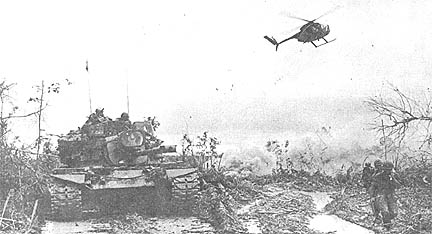 |
| KEEPING AN EYE ON THINGS - Lieutenant Colonel Bruce Williams, 2d Battalion, 22d Infantry commander oversees a combined Triple Deuce-2d Battalion, 34th Armor-ARVN operation from a light observation chopper. |
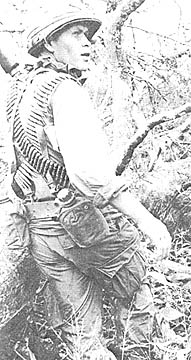 |
PRIVATE FIRST Class William T. Keener of Conover, N.C., checks his buddies’ location before moving on, |
| EVERY ROAD is a throughway for the Triple Deuce APCs, rolling at right along a trail that harbors stumps, roots, rocks and an occasional enemy mine. | 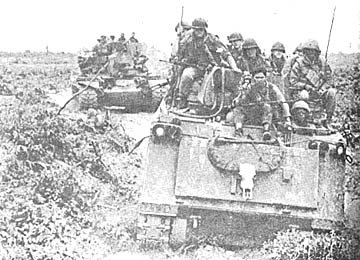 |
 |
A Dreadnought tank and ARVN soldiers prowl through the forest. The tanks are welcome company for the foot soldiers, who never know when they’re going to need some extra firepower. |
| TOUGH GOING is still ahead, but the Triple Deuce infantrymen are ready to confront it, whether they’re riflemen who are walking arsenals or medics who are walking hospitals. | 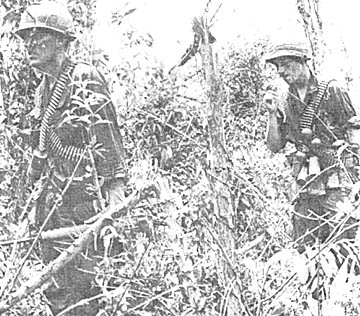 |
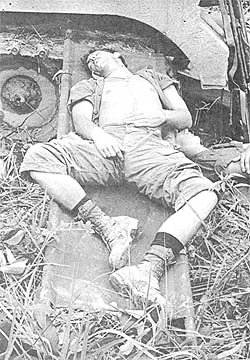 |
REST PERIOD - The end of the day’s mission means a chance to get a brief rest before checking out defensive positions. Specialist 4 David J. Bonanno of Amsterdam, N.Y., makes the most of the opportunity. |
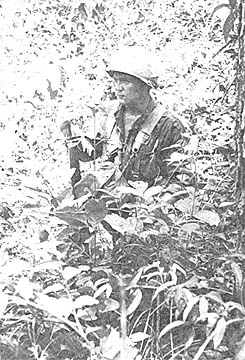 |
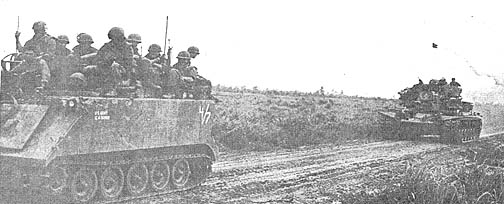 |
| GOIN’ HOME - With the day’s operation over, APCs of the 2d Battalion, 22d Infantry and tanks of the 2d Battalion, 34th Armor return to their night defensive positions (above), ending another day that showed the value of combined armor-infantry maneuvers. |
Page 6 TROPIC LIGHTNING NEWS September 29, 1969
Warriors Call Home
MARS Comes to Boonies
FSB PERSHING - Now that there has been a trip to the moon, more and
more people back in the World are talking about a trip to Mars.
But there are 2d Brigade Warriors here who visit MARS whenever they
can, and come away as high as if they had been to outer space.
The Military Affiliate Radio Station, which has been dubbed MARS,
has been serving troops in the field for about three months. The mobile
station is now here, at the home of the 2d Battalion, 12th Infantry.
After contacting his parents in Chicago, Ill., Warrior Specialist 4
Robert A. Walton said, “Getting to talk to the folks at home really made me
feel good. It’s still hard to believe that I called home from out here
in the boonies.”
Staff Sergeant John Bacino of San Pedro, Calif., is the
noncommissioned officer in charge of the MARS mobile unit. He described
his work by saying: “I have a very rewarding job. I get to see a lot of
happy faces every day.”
A trip to the Vietnam MARS may not be as fantastic as a ride
through outer space, but it is every bit as exciting to the field trooper who
takes it.
| HI, THIS IS MARS - SP4 Robert A. Walton, Chicago, talks to the folks at home while operator SP4 Robert N. Shields of Woodbury, N.J., monitors the radio. (PHOTO BY SP4 LARRY GOODSON) | 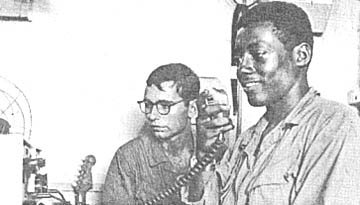 |
Regulars’ S-5 Finds No Failure To Communicate
TAY NINH - Operating with the well-known Oriental axiom, “one
picture worth 1000 words” in mind, Captain John W. McIntosh, S-5 officer for
the 3d Battalion, 22d Infantry, has discovered a new way to reach Vietnamese
civilians during civic action programs in Tay Ninh Province.
McIntosh brings his Polaroid camera with him, and moves into crowds
of sometimes wary and cautious villagers, snapping instant pictures that bring
broad smiles of delight.
McIntosh found that when his civic action and MEDCAP teams went
into villages, it was mostly youngsters who came.
He later discovered that the elders could be reached through
photography.
“If I’m able to win the older folks to our side,” McIntosh
said, “then next time we come to this village the children and grandchildren
of these elders will all be here. These are the people we are trying to
reach - the 20-to-40 age group.”
Who Cares? Wolfhounds, CARE Do
By SP4 PHIL JACKSON
CU CHI - School started for 80 youngsters of Loc Cua village
recently, thanks to some help from the 2d Battalion, 27th Infantry civil affairs
group and the American CARE program.
The battalion’s S-5 section threw its civic action machine into
gear and distributed packets of school supplies made available through CARE, the
American organization that aids people throughout the world. The Wolfhound
team also left medical supplies with the school nurse, so attention could be
given to the children when the battalion medical civic action team is working
elsewhere.
Captain Jerry Parks of Sioux City, Iowa, battalion S-5 officer, has
visited the school many times to help the nuns in aiding their students and the
rest of the village’s citizens.
“The school head mistress told me that without the assistance
they received from the American people, many of the village’s children would
be without school supplies.”
| THE FIRST DAY of school, and the children of Loc Cua village await the chance to try out their new school supplies, distributed to them by the 2d Battalion, 27th Infantry Wolfhounds. (PHOTO BY SP4 PHIL JACKSON) |  |
DIVARTY Has Big Guns in ‘Other War,’ Too
By SP4 KEN FAIRMAN
CUCHI - Division Artillery conducts a medical civic action program
(MEDCAP) to help the Vietnamese people fight the battle against sickness and
death they could not fight alone.
Longer and better lives for adults and children are being made
possible through this pacification program.
A MEDCAP team consists of one or two US doctors, a medic, an ARVN
interpreter and Vietnamese nurses. Upon request of village officials, the
MEDCAP team will enter a village and set up medical equipment at the village
market or school. Some villages have their own dispensary, but most do
not.
PEOPLE LINE UP for treatment even before the team gets there.
Illnesses range from common colds to tuberculosis, from backaches to torn
muscles.
Minor injuries, such as cuts and bruises, are treated by a medic.
The doctor looks after most of the people who attend the MEDCAP, while the
nurses administer injections against plague, flu, typhus and other diseases.
On one MEDCAP recently, Captain Donald D. Home of Wheaton, Ill.,
the battalion surgeon from 3d Battalion, 13th Artillery, administered treatment
to 110 people. The big problem, according to Home, is with skin diseases,
vitamin deficiency and worm infestation.
“ABOUT 15 TO 20 PER CENT of all patients have these problems,”
Home says. “Most are children under 14 years old. With the proper
antibiotics and sanitation they can be cured completely.”
At Cu Chi Base Camp, the 12th Evacuation Hospital is training ARVNs
to be medics. The next program will be teaching Vietnamese girls to be
nurses and work in their own villages. This will aid the government of
Vietnam programs that train medics and nurses.
More is being done to cure many of the people’s ailments as
quickly as possible. US medics are being trained to pull teeth so patients
can be helped right in their own village.
IF SERIOUS cases arise, a Vietnamese will be admitted to a
hospital; either a Vietnamese hospital in Tay Ninh or Saigon, or the U.S. 12th
Evacuation Hospital. In emergency cases, dustoffs can be called to the
village.
Recently, a village chief requested mass plague immunization for
the 3000 people of his village. In a combined effort, Division Artillery
Headquarters and 3d Battalion, 13th Artillery, responded by giving the necessary
vaccine, needles and syringes for use by Vietnamese nurses from the Trang Bang
District dispensary.
Page 7 TROPIC LIGHTNING NEWS September 29, 1969
Regulars Hear AIT Echoes:
‘Are We Clear on the Right?’
BY SP4 K. C. CULLEN
TAY NINH - ”Are we clear on the right? Are we clear on the
left? The firing line is now clear, go down range and mark your
targets.”
The voice of a range safety officer would be familiar to trainees
at Fort Polk or Fort Lewis, but it was recently ringing in the ears of the men
of the 3d Battalion, 22d Infantry. Zeroing and safety classes were given
to each of the companies of the Regulars at Trang Sup, a CIDG training center
outside Tay Ninh.
Classes on weapons were part of the program of refresher courses
for the battalion. Along with a rehashing of AIT topics, field expediency
methods were discussed. Question and answer periods were also held to
explain new ideas and get rid of bad habits which troopers might have developed
while in the boonies.
THE CONTINUING education of the light weapons infantryman does not
end with the rifle and other organic weapons but extends to patrolling, ambush
techniques, use of supporting fire and radio operation.
Maintenance of the workhorse radio, the
PRC-25, was a major topic in the instruction on radio procedure. Again
field expedience for cleaning the various connections, keeping the handset dry
and how to keep a ten foot whip antenna ten feet long were all covered and the
RTO’s had many good tips to pass to the instructor and to their colleagues.
“I thought most of the ‘pro’ words I used over the net were
correct,” said Private First Class Don Pollack of Chicago, an RTO with the
Regulars’ Alpha Company. “I was really surprised to find out that many
of the things I considered everyday were definite no-no’s.”
Although the men were apprehensive about the program at first,
their general attitude has become one of helpfulness. They often offer
suggestions based on experience in the field. These are noted by the
instructor and passed on to the next class.
The small points that become hazy while in the field become clear
again. And as in any type of work, the infantryman must continue to learn
and review in order to become proficient in a job where proficiency might be a
life saver.
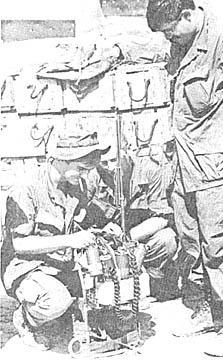 |
SENIOR RTO of the Regulars’ Alpha Company, SP4 James Philebaum (left), goes over some of the fine points of radio procedure during a class for PFCs Nelson Klein and Don Pollak. (PHOTO BY SP4 K. C. CULLEN) |
Chaplain Celebrates Mass For Lap Dien’s Catholics
BY PFC CRAIG SAMPSON
CU CHI - “It’s something new and sort of an experiment,”
explained Major Joseph Graves of Rock Island, Ill., Catholic chaplain for the 2d
Battalion, 27th Infantry. as he spoke of his plans to hold Mass for 300 families
of Lap Dien, a small hamlet nine miles west of Cu Chi.
Graves had been in the vicinity of the predominantly Catholic
hamlet only two days prior to hold services for a platoon of the 2/27th’s
Bravo Company, currently attached to the 4th Battalion, 49th ARVN Regiment.
He extended an invitation to local villagers to join in the services.
THE INVITATION was gratefully accepted, and Graves sent word to the
hamlet that he would come two days later.
“I had a double purpose in going,” he added. “One was
religious, of course, the other pacification.”
AFTER INTRODUCTIONS and a brief tour of the hamlet, Graves and his
interpreter were led to a large stone church near the hamlet’s center.
It was obvious the villagers were proud of the structure, which many of them had
helped build in 1956. Rosaries and scapular medals were then distributed.
With preparations finished, mass could begin. Approximately
100 Vietnamese men, women, and children filed to their seats. Mass was
said in English, while the interpreter translated into Vietnamese.
| MINGLING with members of his Vietnamese congregation, Major Robert Graves, Catholic chaplain of the 2d Battalion, 27th Infantry, prepares to say Mass in the village of Lap Dien. (PHOTO BY PFC CRAIG SAMPSON) |  |
|
Radio Is Deadly Weapon, Clan RTOs Learn |
|||||||||
|
Page 8 TROPIC LIGHTNING NEWS September 29, 1969
Horsemen Groom ARVN Cav
By SP4 JAMES II. STALNAKER
CU CHI - With more and more emphasis being
placed on Vietnamese participation in combat operations, the 3d Squadron, 4th
Cavalry was given the mission of conducting refresher training for the 10th ARVN
Cavalry Squadron.
The training was conducted through practical exercises and
participation in actual operations with 3/4th Cav troops. Classroom type
instruction was kept to a minimum and limited to key ARVN soldiers.
Although the ARVN unit was under the operational control of the 3/4th Cav, it
was totally commanded by ARVN officers.
THE FIRST DAY was devoted to lessons in tactical movement over
roads and cross-country. The job of the Cavmen was to orient the Viet
troopers, using lessons learned in combat.
Hypothetical situations were presented to the ARVN troop commander,
and the 3/4th Cav officers and NCOs acting as observers and cadre were
thoroughly impressed at the speed and discipline with which the Viet armormen
moved.
“I was very pleased to find the proficiency of this unit so
high,” commented Captain James M. Weller of Carbondale, Ill., who was the US
officer-in-charge. “The troop commander has been to Fort Knox, Ky., to
learn basic armor tactics, and holds classes with his platoon leaders daily.”
FIRST LIEUTENANT Jeffrey Babb of Denver, Colo., who spent his time
riding with the line platoons, said, “With a little more training and
experience the ARVN Cav will be a really outstanding unit.”
The ARVN cavalrymen also showed a talent for road security and
convoy escort. Using mine detectors, the ARVN troops cleared a sector of
the supply route from Cu Chi to Tay Ninh.
They then moved into their outposting position and demonstrated
their reaction to an enemy ambush. Unit organization and movement control
were also covered. The remainder of the training consisted of recon in
force through heavy vegetation and hedgerows, cavalry-infantry operations and
selection and placement of night laager positions.
THE ARVNS taught the GIs a lesson in occupying a night laager site.
The South Vietnamese waited until the sun had gone down, and then moved into
their position. In total darkness and almost total silence, the ARVNs
moved their APCs into position and in a matter of minutes had set out trip
flares and claymores and strung concertina wire completely around their
perimeter.
Captain John T. Wells of Cumberland, Ky., was the S-3 officer,
while Weller was the OIC. First Lieutenant Joseph Krawxzyk, Staff Sergeant
Major Delano Armetage and Sergeant First Class George Bishop served as cadre.
The training concluded with an awards presentation, the 3/10th ARVN
Cav receiving a plaque from Lieutenant Colonel Joseph R. Paluh, commanding
officer of the 3/4th Cav. Each ARVN officer was presented with a
certificate making him a lifetime honorary member of MacKenize’s Raiders.
 |
SHERIDAN TANKS and APCs of the 3d Squadron, 4th Cavalry come on line to blast away at suspected enemy positions in a maneuver that is a vital part of the lessons the 3/4 Horsemen taught in training ARVN cavalrymen. |
Warriors Use Their Heads To Tote Radio
CU CHI - One often hears it said that today’s American fighting
man is the best equipped soldier in the world, and maintaining that reputation
is a continuing process.
One of the latest improvements is the addition of the PRC-88 squad
radio.
The PRC-88 is small, lightweight and easy to operate. It can
transmit as well as receive messages. The transmitter can be attached to a
man’s helmet so that both of his hands can be kept free.
POINTMEN OF the 2nd Battalion, 12th Infantry Warriors have recently
begun using the PRC-88.
The pointman is a key man in the squad. It is his job to keep
the squad leader abreast of what the squad is moving into. He is often the
first man to spot the enemy, a booby trap or anything that looks suspicious.
Using the PRC-88 he can quickly warn the squad leader, who in turn
will alert the squad to whatever danger lies ahead.
Since this new radio works both ways the squad leader can talk to
his pointmen if necessary.
Specialist 4 Thomas T. Manazarres of Provo, Utah, a C Company squad
leader said, “When we have a new man on point and I see him doing something
wrong, I can talk to him fast using the new radio and keep him from making a
costly mistake.”
PRC-88 is also put to good use on night ambush patrols. The
rear security men as well as the pointmen are equipped with PRC-88s. Thus,
the squad leader can be kept informed of whatever is going on at both ends of
the file.
Effective command and control of units in the field has always been
extremely important. Use of the PRC-88 squad radio helps to make the task
easier.
“Its one of the most useful new pieces of equipment we’ve
gotten in a long time,” Manazarres said.
|
A WOLFHOUND of Bravo Company, 2d Battalion, 27th Infantry inspects part of a cache, including a kerosene stove, that the US troopers found near the Cambodian border.
|
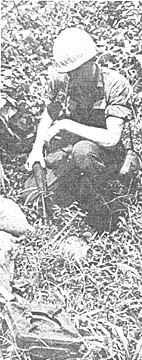 |
Not Invited; Wolfhounds Crash Party
By SP4 PHIL JACKSON
CU CHI - Wolfhounds of the 2d Battalion, 27th Infantry, crashed a
dinner party for 15 recently.
The Tropic Lightning 3d Brigade troopers discovered an NVA camp
site with food cooking on the fire and 100 pounds of rice in the bushes.
The area was on the western bank of the Vam Co Dong River, 13 miles
west of Tropic Lightning’s base camp at Cu Chi.
THE TROPIC Lightning forces were working with Vietnamese-piloted
troop carriers from the Tra Cu Special Forces camp.
After a wet insertion in the vicinity, the infantrymen moved one
kilometer west through waist-deep mud and chest-deep canals. Suddenly,
“Duke,” a scout dog, alerted. The point man saw the camp fire and
scattered food across a canal that was to the company’s front.
Specialist 4 John Spencer of Syracuse, N.Y., was walking with the
dog and handler.
“We were about to cross a deep canal when we found ashes from a
fire, bowls of rice and bananas scattered around. When I was halfway
through the canal I stumbled on a submerged object which turned out to be a
sampan,” Spencer said.
SECURITY WAS immediately put out while the area was checked for
possible enemy stragglers hiding in the tree lines.
A light fire team was called to support Bravo Company, which moved
west in pursuit of the foe. A few more bunkers and articles of clothing
were found along another canal.
By day’s end, the total cache consisted of the rice, 40 pounds of
salt, a Chinese-manufactured portable stove with kerosene supply, entrenching
tools, clothing, a sampan, and three bunkers with overhead cover (destroyed).
 |
NEW DIVISION COMMANDER, Major Harris W. Hollis, accepts the Division Colors from General William B. Rosson, MACV Deputy Commander, during change of command ceremonies at Ilikai East Service Club in Cu Chi. Outgoing Division Commander Major General Ellis W. Williamson passed the flag to General Rosson during the ceremonies, which were forced indoors by rain. (PHOTO BY SP4 KARL KARLGAARD) |
Thanks to
Ron Leonard, 25th Aviation Bn., for locating and mailing this issue,
Kirk Ramsey, 2nd Bn., 14th Inf. for creating this page.
This page last modified 8-12-2004
©2004 25th Infantry Division Association. All rights reserved.